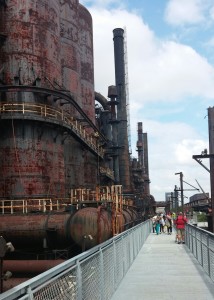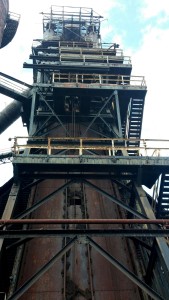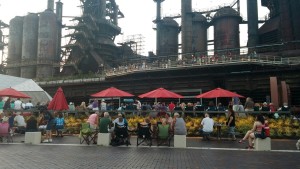Hoover-Mason Trestle Lets Visitors “Steel” A Glance At Industrial History
For more than a century the blast furnaces of Bethlehem Steel have loomed over the south side of the company’s hometown, towering icons to the Industrial Age and one of the toughest, most dangerous ways to make a living ever conceived by man.
From a distance, they are inspiring.
Up close, they are impressive.
Standing just yards away on a steel-grate walkway 45 feet in the air, they are downright awesome.
That’s the point of the Hoover-Mason Trestle – a 2,000-foot long walkway that gives visitors a view of these massive artifacts previously seen only by the men and women who risked their lives working on them, day in and day out, 24 hours a day, seven days a week, 365 days a year, for almost 100 years.
Completed this spring and opened at the end of June, the $15 million trestle – built by the Bethlehem Redevelopment Authority and named for the engineering firm that designed the original railway that delivered iron ore, coke and other materials to the furnaces – stretches a third of a mile across what is now the home to Musikfest’s parent organization, ArtsQuest, and WLVT-39, the Lehigh Valley’s Public Broadcasting System television studios.
Dotted with small gardens reminiscent of New York’s High Line Park and the remnants of the once-mighty Steel, the walkway features plaques that describe both the steel-making process and the context of what it meant to work on the furnaces. Abandoned rail cars still sit on the original rail trestle, silent testament to the magnitude of the tasks, and visitors can peer into long-vacant buildings, such as the Blower House with its enormous generators, and Machine Shop #2, once the longest industrial building in the world.
The five remaining blast furnaces were the heart of the Bethlehem Steel’s home plant that at one point sprawled over almost 1,800 acres along the Lehigh River and employed more than 35,000 people. Bethlehem Steel and its iconic “I-beam” were fundamental components of American construction throughout the 20th Century, contributing to the durability of such notable landmarks as the Chrysler Building, Hoover Dam and Golden Gate Bridge.
But standing on the trestle as the furnaces rise another 15 stories (a total of 200 feet) above you, it is breath-taking to imagine the exploits of the men – and they were mostly men – who had to traverse the network of catwalks, ladders and other obstacles that entwine the furnaces that operated continuously in all weather and had to be kept running, whatever the costs.
Visitors like Donna Hosler and Bud Charlton of Oxford, Chester County, stand in quiet wonder as they look up and up and up.
“As a volunteer firefighter for 25 years, I am astounded by the efforts made by those steelworkers,” said Charlton, who works for Herr’s Foods. “The Trestle is an inspiring memorial to those who made a living, and sometimes died to support an industry that helped to make America a super power. I hope future generations recognize the sacrifices made by those who went before them. “
Hosler, an Oxford native who spent much of her adult life in Bethlehem, praised the visionaries who created the trestle and are breathing new life into the Steel properties.
“They’ve turned an abandoned brown-field into an exciting venue for entertainment,” said Hosler, who now works as the Main Street manager in Oxford. “We were at the Levitt Pavilion to see a show and decided to make the climb to see what was happening above the stage. We were rewarded with an incredible view of the Steel Stacks area and an inspiring look at the remains of Bethlehem Steel. The park-like atmosphere, with small gardens and red lights shining on the stacks will make you want to linger.”
If You Go: The Hoover Mason Trestle is located at SteelStacks, 711 First St., Bethlehem. It is open from 8 a.m. to 8 p.m. Sunday to Wednesday and 8 a.m. to 9 p.m Thursday to Saturday. Admission is free. Click here to learn more.
What To Know: There are three points of entry/exit: Stairs at each end of the walkway and in the middle, and an elevator for accessibility. Parking is available at SteelStacks or the Sands Casino lot at the south end of the trestle. The Trestle may be closed for safety reasons during inclement weather.
Fact: More than 500 workers were killed at Bethlehem Steel between 1900 and 1940 when the company finally accepted organized labor and future contracts provided for safer working conditions and shorter hours. The furnaces, which date to 1903, finally went quiet on Nov. 18, 1995.










